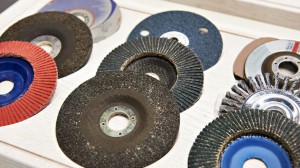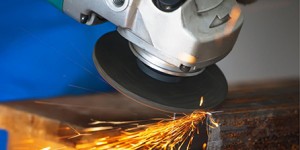The lightweight Angle grinder, with its compact and flexible features, has become a commonly used tool in home decoration, maintenance, DIY handicrafts and other scenarios. But to make it play a greater role, the cooperation of various accessories is indispensable. These seemingly simple accessories can transform the Angle grinder from a single cutting tool into a “versatile hand” capable of grinding, polishing and rust removal. Not only does it reduce the trouble of changing tools, but it also significantly improves work efficiency. This article introduces 15 practical accessories to see how they can make a light Angle grinder more user-friendly.
Cutting accessories: Precise, effortless and fast cutting
Cutting is the core function of an Angle grinder. The right cutting disc can make the cut neater and also protect the machine.
Resin cutting discs are the most commonly used. They are thin and sharp, and are suitable for cutting metal pipes and steel bars. Choose a diameter of 100 to 125 millimeters (the commonly used size for light Angle grinders). When cutting, do not apply too much force. Follow the marked line slowly, and the cut basically does not need to be ground a second time.
Stone cutting discs (mostly made of diamond) are specifically designed for tiles and marble. Dust is produced during cutting. It is best to use water spray to cool down, which not only protects the cutting disc but also makes the cut surface smoother. It is especially suitable for cutting floor tiles during home decoration.
The bimetallic saw blade, like a small electric saw, features a serrations design and is suitable for cutting wood and PVC pipes. Compared with traditional saws, when using an Angle grinder with this saw blade for cutting, the speed can be three times faster, and it can also cut curves. It is very convenient for woodworking.
Ultra-thin cutting discs (with a thickness of less than 1 millimeter) are suitable for fine cutting, such as creating narrow slits on metal plates. They do not waste too much material, and the cut edges are neater, reducing the workload of subsequent grinding.
Polishing accessories: Make the surface as smooth as new
Grinding is the “hidden skill” of an Angle grinder. With the corresponding accessories, it can handle the surfaces of various materials.
Grinding wheels (coarse sand, medium sand, fine sand) are suitable for rust removal and deburring of metals. The edge of the freshly cut metal is very sharp. Grind it with a coarse grinding wheel and then switch to a fine grinding wheel to smooth it out. It will feel smooth when touched and there is no need to worry about cutting your hand.
The sandpaper wheel (like a small windmill) is suitable for grinding wood and plastic. When doing home decoration and polishing wooden doors and furniture, using a hundred-wheel sandpaper is 10 times faster than manual sandpaper. It can also polish curved surfaces and take care of dead corners.
Wire wheels are divided into coarse wire and fine wire types. Coarse wire wheels are used to remove thick rust and old paint from the surface of metals, while fine wire wheels can polish metals, such as grinding old steel pipes to a shiny finish, eliminating the need for repainting.
Nylon wheels are relatively soft in texture and are suitable for polishing stainless steel and aluminum alloy. For instance, when polishing the edges of sinks or aluminum alloy window frames, gently rubbing them with a nylon wheel can remove scratches without damaging the material itself.

Polishing accessories: Easily create a shiny surface
If you want to make the surface of an object shiny, grinding alone is not enough. These polishing accessories can be of great help.
When used in combination with polishing wax, wool wheels can be used for mirror polishing of metals and stones. For instance, for old copperware and stainless steel countertops, after polishing with a wool wheel, they can regain their brand-new luster, which is much less laborious than wiping with a cloth.
Sponge polishing wheels are suitable for polishing the paint surfaces of automobiles and furniture. Minor scratches can be removed by dipping a sponge wheel in polish and slowly grinding. There’s no need to go to a specialized repair shop; you can handle them at home by yourself.
Cloth wheels (wheels made of cotton or linen) are suitable for polishing wood and plastic. For instance, handcrafted wooden spoons and plastic toys, when tossed with a cloth wheel, will become warm and smooth on the surface, providing a better feel.
Special function accessories: Solve corner and detail problems
For some tricky scenarios that ordinary accessories can’t handle, these “niche” accessories can come in handy.
The conical grinding head (like a small cone) is suitable for grinding burrs on the inner side of pipes and around screw holes. For instance, for a freshly drilled metal plate with burrs at the edge of the hole, a conical grinding head can be inserted and rotated once to clean it thoroughly.
Bowl-shaped grinding wheels (with arc-shaped edges) are suitable for grinding curved surfaces or concave areas. For instance, for the elbows of metal pipe fittings and the connection points of tool handles, a bowl-shaped grinding wheel can be used to fit the curved surface and grind more evenly.
Diamond grinding heads (with fine diamond particles on the head) can grind glass and tiles. If you want to make a small hole in the glass, first use a diamond grinding head to slowly grind out a mark, and then cut it. This way, it won’t break easily.
The sandpaper tray (which can stick sandpapers of different thicknesses) is suitable for fine grinding of small areas. For instance, when doing detailed processing for models and small wood carvings, simply changing to different sandpapers can enable you to go from coarse grinding to fine grinding in one step.
The slotting wheel (with grooves on the edge) can make grooves on stone and concrete. When doing home decoration, it is necessary to bury wires. Using a slotting wheel to make neat grooves on the wall is less laborious than chiseling with an electric hammer and will not damage the surrounding walls.

Tips for Using Accessories
When changing parts, be sure to cut off the power first. Wait until the Angle grinder has completely stopped before operating. Safety comes first. The rotational speeds of different accessories vary. For instance, cutting discs are suitable for high speeds, while polishing wheels can be set a bit slower to prevent damage to accessories or objects due to excessive speed.
Accessories should be replaced in time after long-term use. For instance, if the cutting disc develops cracks or the grinding wheel is severely worn, continuing to use it may cause injury from broken debris. When not in use, dry the accessories and store them in a dry place, especially the wire wheels and grinding wheels. Moisture can easily cause rust and affect the performance.
The accessories of a light Angle grinder are like “different tool heads”. If the right accessories are replaced, one machine can be used for at most multiple purposes. Whether it’s cutting, grinding or polishing, choosing the right accessories can not only improve efficiency but also make the work look more beautiful. For those who often do hands-on work, spending some time getting to know these accessories can double the value of the Angle grinder and make complex tasks simple.
Post time: Jul-30-2025

